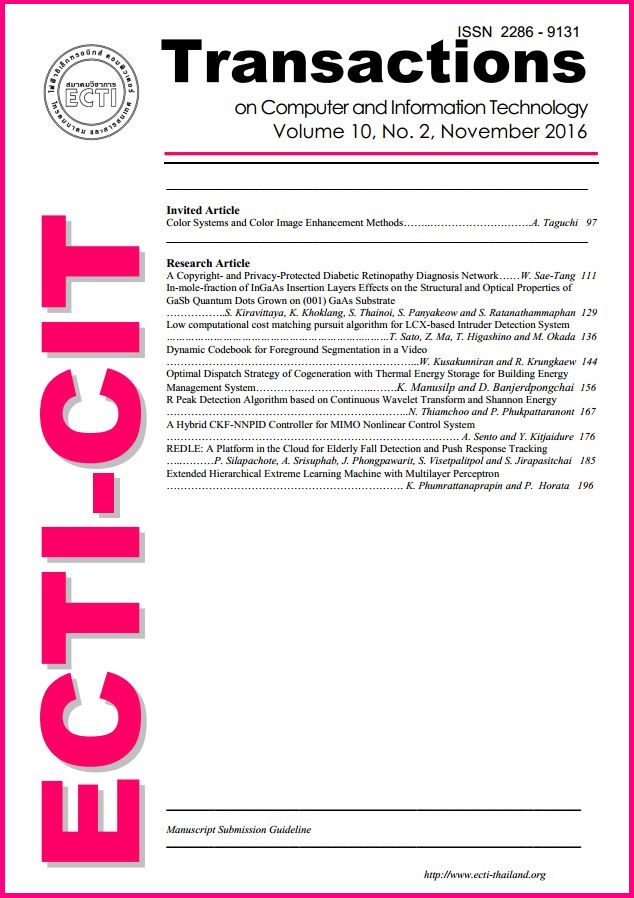Optimal Dispatch Strategy of Cogeneration with Thermal Energy Storage for Building Energy Management System
Main Article Content
Abstract
This paper presents optimal dispatch strategy of cogeneration with thermal energy storage (TES) for building energy management system (BEMS). In previous research related to cogeneration as a supply system, it is observed that there is some excessive heat from cogeneration operation released to the atmosphere. In order to improve energy efficiency, we therefore incorporate TES to utilize the excessive heat from cogeneration into two objective functions, i.e., total operating cost (TOC) and total carbon dioxide emission (TCOE). In particular, we aim to minimize TOC which is referred to economic optimal operation and to minimize TCOE which is referred to environmental optimal operation. Both optimal operations are subjected to energy dispatch strategy which TES constraint is taken into account. We demonstrate the dispatch strategy with a load profile of a large shopping mall as a test system and compare the results to that of previous dispatch of cogeneration without TES. The proposed strategy of cogeneration with TES can reduce TOC of the test system up to 4.15% and 1.85% for economic and environmental optimal operations, respectively. Furthermore, TCOE can be reduced up to 5.25% and 6.25% for economic and environmental optimal operations, respectively.
Article Details
References
Z. Jiang and H. Rahimi-Eichi, “Design, modeling and simulation of a green building energy
system,” IEEE Power & Energy Society General
Meeting, Calgary, AB, pp. 1-7, 2009.
D. Estates, “Building energy management systems,” Her Majesty’s Stationery Office, Ministry
of Defense, United Kingdom, Jan. 2001.
S. Yokoyama, “A Guide for Biomass Production
and Utilization,” The Asian Biomass Handbook,
pp. 94-97, 2008.
U.S. Environmental Protection Agency
and Combined Heat and Power Partnership (Dec. 2008). Catalog of CHP
Technologies [Online]. Available from:
www.epa.gov/chp/documents/catalog chptech
full.pdf.
Energy, Ministry. Energy Policy and Planning Office, “Thailand Power Development
Plan 2015-2036 (PDP2015),” Energy Policy and
Planning Office. Ministry of Energy. Thailand. [Online]. June 2015. Available from:
www.egat.co.th/en/images/
C.-C. Tseng, W.-H. Lin, S.-Y. Wu, S.-H. Chen,
and S.-Y. Lin, “The transition mechanisms of
type-II GaSb/GaAs quantum-dot infrared lightemitting diodes,” J. Cryst. Growth, Vol. 323, pp.
-469, 2011.
M. T. Tsay, W. M. Lin, J. L. Lee, “Interactive best-compromise approach for operation dispatch of cogeneration systems,” IEE Proceedings: Generation, Transmission and Distribution, vol. 148, no. 4, July 2001.
R. Hashemi, “A Developed Offline Model for Optimal Operation of Combined Heating and Cooling and Power Systems,” IEEE Transactions on
Energy Conversion, vol. 24, no. 1, pp. 222-229,Mar. 2009.
T. Petkajee and D. Banjerdpongchai, “Design
of Cogeneration and Analysis of Economic and
Environmental Optimal Operations for Building
Energy Management System”, ECTI Transactions on Electrical Engineering, Electronics, and
Communications (EEC), vol. 11, no. 2, pp. 79-94, Aug. 2013.
K. Manusilp and D. Banjerdpongchai, “Optimal dispatch of cogeneration with thermal energy storage for Building Energy Management
System,” 2016 13th International Conference on
Electrical Engineering/Electronics, Computer,
Telecommunications and Information Technology (ECTI-CON), Chiang Mai, pp. 1-6, June2016.
“Fuel Prices in December 2015”, Department of
Mineral Fuels, Ministry of Energy, Thailand,
Dec. 2015.
United States Environmental Protection
Agency (US EPA) and Combined Heat and
Power Partnership. “Catalog of CHP Technologies. US EPA. United States of America,”
[Online]. December 2008. Available from:
http://www.epa.gov/chp/documents/catalog
chptech full.pdf
L. V. Wortswinkel and W. Nijs, “Industrial Combustion Boilers,” International Energy Agency Energy Technology Systems Analysis Program (IEAETSAP) [Online]. May 2010. Available
from: http://www.ieaetsap.org/web/etechds/pdf/i01-ind boilers-gs-ad-gct1.pdf.
United States Environmental Protection Agency
(US EPA). Office of Atmospheric Programs. Climate Protection Partnerships Division and Climate Change Division. “Climate Leaders Greenhouse Gas Inventory Protocol Offset Project
Methodology for Project Type: Industrial Boiler
Efficiency,” Climate Protection Partnerships Division and Climate Change Division. Office
of Atmospheric Programs. US EPA. United
States of America. [Online]. Available from:
http://www.epa.gov/climateleadership/documents/resresour/industrial boiler protocol.pdf
ECTI TRANSACTIONS ON COMPUTER AND INFORMATION TECHNOLOGY VOL.10, NO.2 November 2016
Metropolitan Electricity Authority
(MEA). “Electricity Tariffs for Large
General Service MEA. Thailand,”
[Online]. Nov. 2015. Available from:
http://www.mea.or.th/upload/download/
file 55c49b349ab063d4bcd0d5033e699707.pdf
Electricity Generating Authority of Thailand
(EGAT). “Electricity Wholesale Prices for
Metropolitan Electricity Authority (MEA) and
Provincial Electricity Authority (PEA)”. EGAT.
Thailand. [Online]. www.egat.co.th
Thailand Greenhouse Gas Management Organization (TGO) (Public Organization).
“Summary Report: The Study of Emission
Factor for an Electricity System in Thailand 2010,” TGO (Public Organization).
Thailand. [Online]. Available from: conference.tgo.or.th/download/tgo or th/ publication/GEF/2010/GEFReport ENrevise4.pdf


